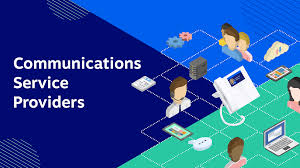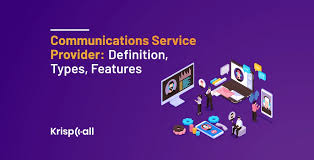

What is a Communications Service Provider?
Catalog
What Is a Communications Service Provider?Types of Communication Service ProvidersBenefits of Communication Service ProviderFeatures of Communication Service ProviderFrequently Asked Questions: Related ArticlesWhat Is a Communications Service Provider?
A Communications Service Provider (CSP) is indeed a business entity that offers various services related to the transmission of information electronically. Here's a brief overview of what a CSP is and does:
1. Service Offerings: CSPs provide a range of services including voice, data, and video communications. This can involve telephone services, internet access, cable television, and satellite communications.
2. Technological Infrastructure: They maintain and operate the necessary infrastructure for these services, which includes networks of fiber optic cables, cellular towers, satellites, and other related technologies.
3. Regulation and Deregulation: As you mentioned, the term became more prevalent in the late 1990s, particularly following deregulation in the telecommunications industry. In the United States, the Telecom Act of 1996 was a significant piece of legislation that allowed for more competition and service overlap in the industry.
4. Convergence: The convergence of technologies has allowed CSPs to offer a broader range of services. What used to be distinct industries—like landline telephony, wireless communications, and internet service—are now often provided by the same company.
5. Managed Services: CSPs also often provide managed services, which can include network management, security services, and other value-added services that help businesses optimize their use of communications technologies.
6. Public and Private Companies: CSPs can be public or private entities, and they operate in both the consumer and business-to-business markets.
7. Global Reach: Many CSPs have a global reach, providing international communication services and often competing on a global scale.
8. Innovation and Investment: CSPs are at the forefront of investing in new technologies to improve service delivery, such as 5G networks, cloud services, and the Internet of Things .
The term "communications service provider" has indeed become an umbrella term that captures the evolving nature of the industry, reflecting the shift from specialized communication services to a more integrated approach to information transmission.


What Is a Communications Service Provider?
Types of Communication Service Providers
1. Internet Service Providers (ISPs):
ISPs are companies that specialize in offering internet access to individuals and businesses. They provide various services such as broadband, DSL, cable, and wireless internet, allowing users to connect to the internet and access its resources.
2. Telecommunications Service Providers (TSPs):
TSPs focus on voice communication services, providing telephone networks, landlines, mobile services, and infrastructure. They facilitate global communication by enabling long-distance conversations between people.
3. Content and Application Service Providers (CASPs):
CASPs are providers that specialize in delivering digital content and applications to users. They offer services such as media streaming, on-demand content, cloud applications, and gaming platforms. CASPs often collaborate with TSPs and ISPs to use their networks for efficient content distribution and enhanced user experience.
4. Satellite Broadcasting Operators:
Satellite Broadcasting Operators use satellites to transmit TV signals and other communication services. They offer TV programming to areas with limited terrestrial infrastructure, specializing in DTH services, satellite radio, and satellite internet connections.


Types of Service Providers
Benefits of Communication Service Provider
1. Enhanced Communication Efficiency:
Communication service providers enhance the efficiency of communication by delivering dependable voice, data, and internet services. This enables more effective management of internal operations and customer interactions, leading to improved overall communication.
2. Scalability and Flexibility:
These providers offer cloud-based communication solutions that can scale with the growth of a business. This flexibility allows companies to adjust their communication infrastructure to accommodate market shifts or business expansion, enhancing their adaptability and responsiveness.
3. Broad Global Connectivity:
Communication service providers enable global interaction by offering services that connect individuals across the world. They facilitate mass communication, making it simpler to establish connections with anyone, regardless of location.
4. Enhanced Customer Service Experience:
Communication service providers equip businesses with reliable communication channels such as voice, email, and chat services. This ensures that businesses can address customer issues promptly, anytime and anywhere, contributing to a more positive customer service experience.


Benefits of Communication Service Provider
Features of Communication Service Provider
1. Superior Audio Clarity:
Communication service providers deliver superior voice quality for crystal-clear interactions, reducing interference and ensuring clarity. This is achieved through both traditional landlines and modern Voice over Internet Protocol (VoIP) services. Advanced codecs and network optimization technologies are utilized to maintain high call quality, even over long distances. This results in natural and uninterrupted conversation flows, which are essential for both personal and professional communication.
2. Sophisticated Call Handling:
These providers equip businesses with advanced call management tools such as call forwarding, automatic call distribution, call recording, auto attendants, and call routing. These tools are designed to efficiently handle a high volume of calls. Call recording is particularly useful for quality control, adherence to best practices, and staff training. Automated responses and intelligent call distribution ensure that customers are quickly directed to the appropriate department or individual, thereby enhancing customer satisfaction.
3. Integrated Communication Platform:
They consolidate voice, email, video conferencing, and instant messaging into a single platform, streamlining workflows and boosting collaboration. This integration saves time by eliminating the need to switch between different applications. It also improves cooperation by enabling efficient communication and planning among team members. A unified approach to communication enhances productivity and ensures clear and consistent communication throughout the organization.
4. Robust Collaboration Tools:
Communication service providers offer a suite of collaboration tools, including video conferencing, screen sharing, and file sharing. Screen sharing facilitates the viewing and interaction with others' screens, which is particularly beneficial for presentations and troubleshooting. File sharing promotes effective collaboration by enabling the easy exchange of documents. These tools, when combined, enhance internal communication, foster teamwork, and improve the performance of projects.


Features of Communication Service Provider
Frequently Asked Questions:
1. Difference between MNO and CSP:
Mobile Network Operators (MNOs) are entities that own and manage the infrastructure necessary for providing mobile telecommunications services. They own and operate the network infrastructure, such as cell towers and base stations, and are responsible for the coverage and quality of service within their network areas.
Communications Service Providers (CSPs): CSPs offer a broader range of services that may include telecommunication services, information and media services, content, entertainment, and application services. They can provide services over various networks, not just mobile networks, and often leverage network infrastructure to deliver a wide array of services.
2. Example of a communication service:
An example of a communication service is a telephone service that allows individuals to make voice calls over a network, whether it's a traditional landline service or a modern VoIP (Voice over Internet Protocol) service.
3. Communication Service Provider:
A CSP is a company that offers a combination of telecommunications, information, media, content, entertainment, and application services over networks. They use the network infrastructure to provide these services, which can include internet access, cable TV, streaming services, and more.
4. Difference between CSP and CSC:
CSP (Communication Service Provider):Refers to companies that provide the infrastructure and services for communication, as described above.
CSC (Cloud Service Customer): In the context of cloud computing, a CSC is an entity that uses cloud services. They are responsible for the management and use of the cloud services they subscribe to, including security and compliance.
5. Uses for CSP:
CSP, in the context of Concentrating Solar-Power, is used to generate electricity by focusing sunlight to heat a fluid, which then drives a turbine. It can also provide heat for industrial processes like water desalination, enhanced oil recovery, and food processing.
6. Purpose of CSP:
Content Security Policy (CSP) is a security standard designed to prevent attacks like cross-site scripting (XSS) and data injection by restricting the sources from which content can be loaded onto a webpage.
7. Benefits of using CSP:
Using a CSP can provide managed services, which means that technical expertise is outsourced to partners who can manage infrastructure, data backup, security monitoring, and application support.
Related Articles
What is Wireless Communications?All Explained
Broadband Communication Technology Solutions
This article is from JMChip Electronics,which cooperates with manufacturers and offer electronic components, semiconductors, antennas, capacitors, connectors, diodes,transistors, lCs.and resistors. For more product information, please go to the website to get it.
Subscribe to JMChip Electronics !



















